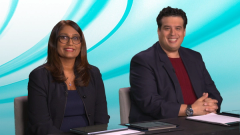
Patient Case 2: A 79-Year-Old Woman With Transplant-Ineligible NDMM
Switching their attention to the transplant-ineligible setting of newly diagnosed multiple myeloma, panelists center discussion around their second patient case.
Episodes in this series

Transcript:
Sundar Jagannath, MD: Dr Rossi, would you present on patients who are not eligible for transplant frontline therapy?
Adriana Rossi, MD: Absolutely. I have a lovely lady who was 79 years old and presented to her primary care doctor in 2019. He ordered an MRI, which we’ll look at in a moment, and it prompted him to do blood work. This was in October 2019. She was found to have an M-spike [monoclonal protein] of 6.2 g. Her beta-2 microglobulin was 5.4 μg/L. Her LDH [lactate dehydrogenase] was within normal limits, and her albumin was down to -2.8 g/dL. Her hemoglobin was 8.2 g/dL, although she seemed asymptomatic. Her creatinine was 1.0 μg/dL, and her calcium was 9.8 μg/dL.
Upon meeting us, we did do a bone marrow biopsy, which was notable for 70% to 75% involvement with her myeloma. And the FISH [fluorescence in situ hybridization]was noted to have a gain of 1q and a trisomy 15. The MRI of her spine [showed] the C [cervical], T [thoracic], and L [lumbar] spine were peppered with innumerable hyperintense-enhancing lesions, which explained her symptoms.
We started induction with daratumumab, lenalidomide, and dexamethasone at standard doses. When the COVID-19 pandemic started, she was very anxious about coming into the office. She refused to come for over a year. We had local lab work to mitigate, and she was essentially on lenalidomide maintenance. Her M-spike continued to respond, and she reached a nadir at 0.2 g. She remained there for over 12 months until she was comfortable coming into the clinic. She was distraught with the toxicity of lenalidomide. She was having diarrhea that made it hard to leave the house. When she was trying to leave the house, she was switched to daratumumab maintenance. After 2 cycles she had no detectable M-spike, and her light chains normalized. Confirmatory marrow was then MRD [minimal residual disease]–negative.
Sundar Jagannath, MD: That’s an interesting case. How old you said she was?
Adriana Rossi, MD: [She was] 79 [years old].
Sundar Jagannath, MD: Older patients cannot be grouped as transplant-ineligible patients, because frailty gets in the way as you go on. You have many choices. You can do 2 drugs, like lenalidomide-dexamethasone or Velcade [bortezomib]–dexamethasone. That was in the olden times. Now we use lenalidomide-daratumumab, as in this case. But in some patients, you can use VRd [bortezomib, lenalidomide, dexamethasone]–daratumumab just as you would have treated a transplant-eligible patient. Is there any way you’d decide whether you will use quadruplet therapy, triplet therapy, or a 2-drug combination in this transplant-ineligible age spectrum, let’s say from ages 75 to over 90 years old?
Adriana Rossi, MD: Yes, absolutely. Age is a number. I have frail patients who are much younger, and I’d treat them much more cautiously. She’s fairly robust, even at age 79, but she had a long-standing history of diabetes. And so for her, I wouldn’t use bortezomib. Concerns for neuropathy would preclude me from using up-front bortezomib. For many patients, especially those with higher-risk features or more aggressive disease, I’d think I could tolerate at least starting with a quadruplet. I don’t commit to it long term. It’s easy to start, get through a cycle or 2, and then drop off either dose or a drug entirely from the combination for tolerability.
Sundar Jagannath, MD: With the older patients, you have only 1 chance to do the best by them because as they relapse, they get older and don’t tolerate salvage therapy.
Adriana Rossi, MD: Every time. [Laughter from the panel.]
Sundar Jagannath, MD: You want to do the best from the get-go. In younger patients, you can say transplant or no transplant, and early vs late transplant. Between ages 55 and 65, in 10 years, there’s no big difference. But between ages 75 and 85, there’s a big difference in the patient? So always try to do your best in the beginning.
Transcript edited for clarity.
Newsletter
Stay up to date on recent advances in the multidisciplinary approach to cancer.






















































































